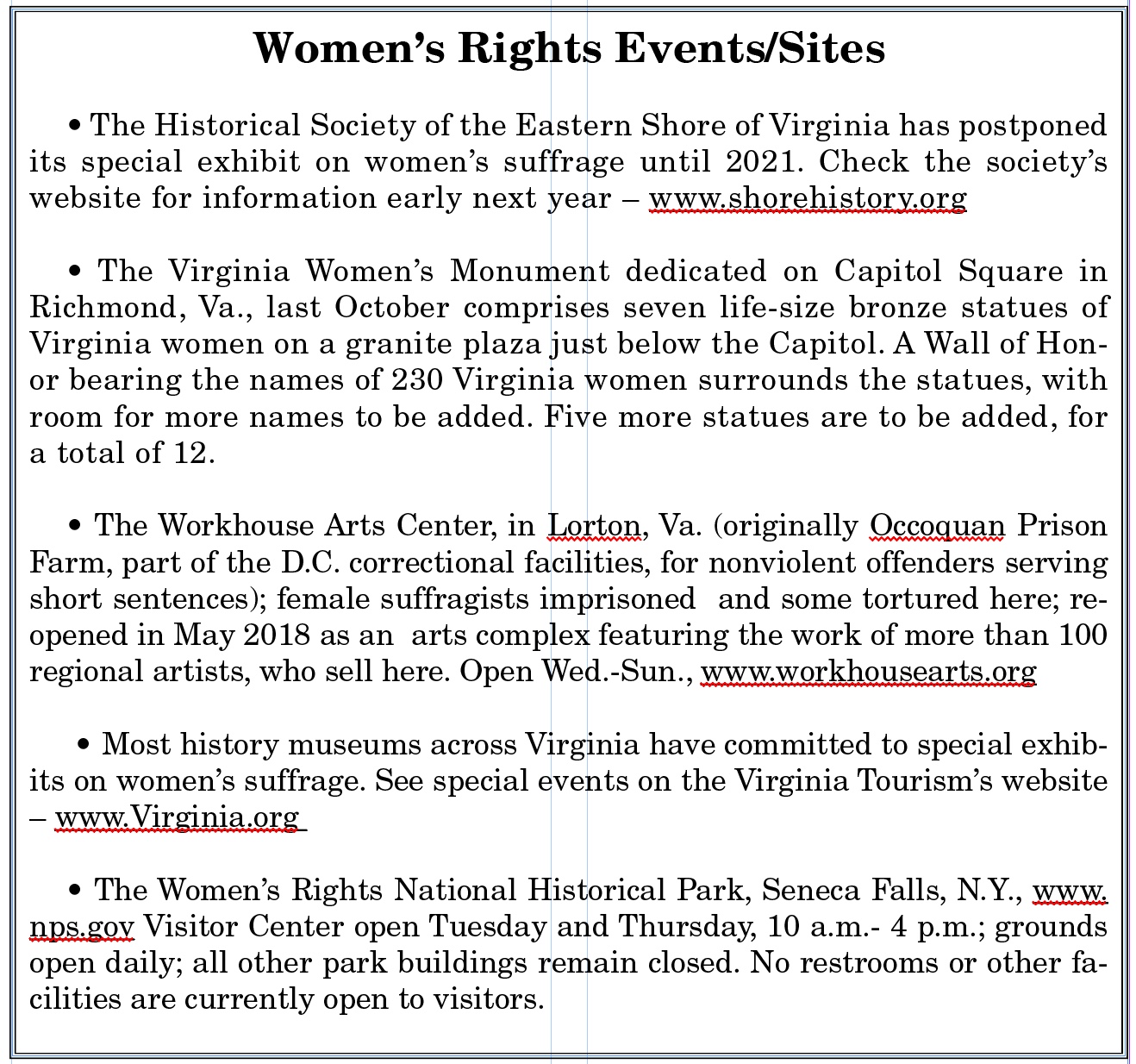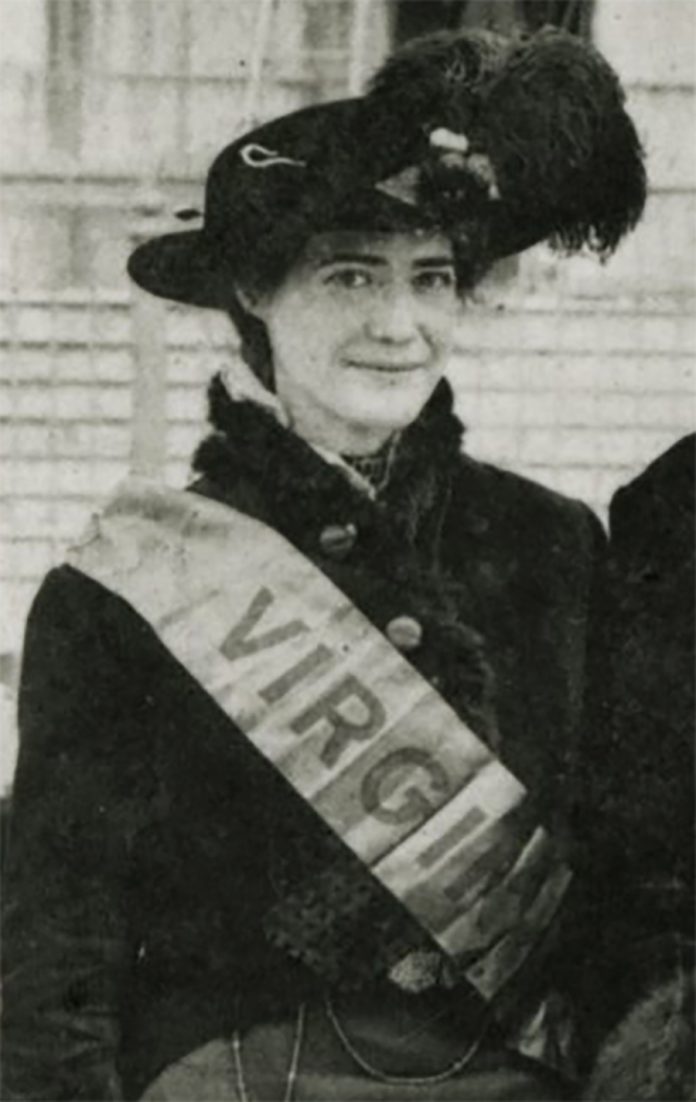
On Aug. 18, 1920, Tennessee became the 36th state to ratify the 19th Amendment. It was adopted into the U.S. Constitution Aug. 26, 1920.
By Martha Wessells Steger
Special to the Eastern Shore Post
If today’s citizens think racial protests raise issues on all sides, they might reflect on the years when women – Black as well as White – sought the right to vote; but many White suffragists did not allow Black women to march with them in parades and forbade them from joining the National Women’s Suffrage Party. Black investigative journalist Ida B. Wells — born into slavery in Mississippi and freed by the Emancipation Proclamation — joined anyway.
Virginia has received many plaudits in its history since the founding of the first permanent English settlement at Jamestown in 1607, but the commonwealth wasn’t on the cutting edge of either civil rights or giving women the right to vote. The state, along with Georgia, took until 1952 to ratify the 19th Amendment, which Congress had passed on June 4, 1919, and which three-fourths of the state legislatures ratified to create the new law of the land on Aug. 26, 1920: “The right of citizens of the United States to vote shall not be denied or abridged by the United States or by any State on account of sex.”
The amendment became known colloquially as the Susan B. Anthony Amendment for the social reformer born in 1820 who played a pivotal role in the women’s suffrage movement. An anti-slavery advocate early in her life — collecting anti-slavery petitions at the age of 17 — she opposed the 15th Amendment, ratified on Feb. 3, 1870, for not including women. The amendment prohibits the federal government and each state from denying the right to vote based on “race, color, or previous condition of servitude.” After her arrest in late November 1872 for casting a vote with 14 other women at their Rochester, N.Y., polling place, she said at her trial, “Women are taxed without representation, governed without their consent, tried, convicted and punished without a jury of their peers.” She refused to pay the $100 fine after her conviction because she maintained she’d done nothing wrong. The government did not attempt to collect it.
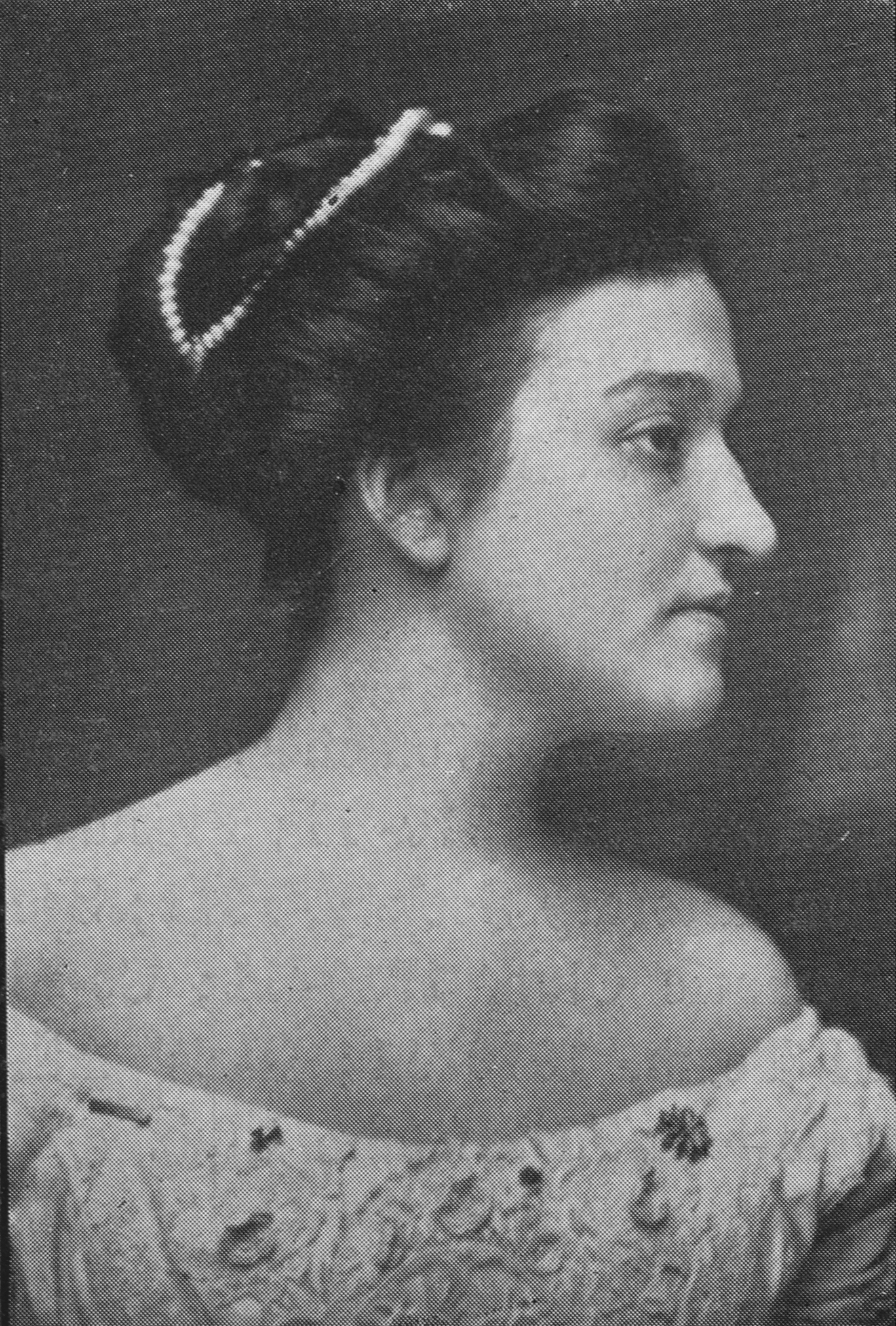
Image courtesy of the Library of Virginia.
On April 7, 1917, Equal Suffrage League of Virginia organizer, writer, and editor Eudora Ramsay traveled from Richmond, Va., to the Eastern Shore, where she helped establish at least six local leagues. The Parksley correspondent for the Eastern Shore Enterprise newspaper mentioned “an interesting lecture on Women’s Suffrage, in Hopkins Hall, Friday night, at the conclusion of which a league was formed.” The group elected Mrs. George Tignall president; Mrs. J.S. Tyler, vice president; and Miss Minnie Mills, secretary.
Although undoubtedly pleased when ballots were finally in women’s hands, she might not have been as pleased to learn that, in the Mappsville precinct for example, only six women registered on Oct. 2, 1920, and “[a] few more registered in subsequent years (1920s) but not many…,” according to Stacia Childers, local history specialist at the Eastern Shore Public Library. If true Shorewide, this contrasts with the state at large, which, according to research by the Virginia Foundation for the Humanities, shows the ESL of Virginia’s membership growing from 100 members in its first year to more than 15,000 by 1917. By 1919, with 32,000 members, it was the largest political organization in the state of Virginia, and perhaps the largest state association in the South. (In mid-August, Childers was inventorying ESPL collections in preparation for the move to its new site; the archives aren’t open to the public yet, and not all collections are cataloged.)
From Richmond to Accomack County

Image from the Adèle Goodman Clark papers, Special Collections and Archives, Virginia Commonwealth University Libraries.
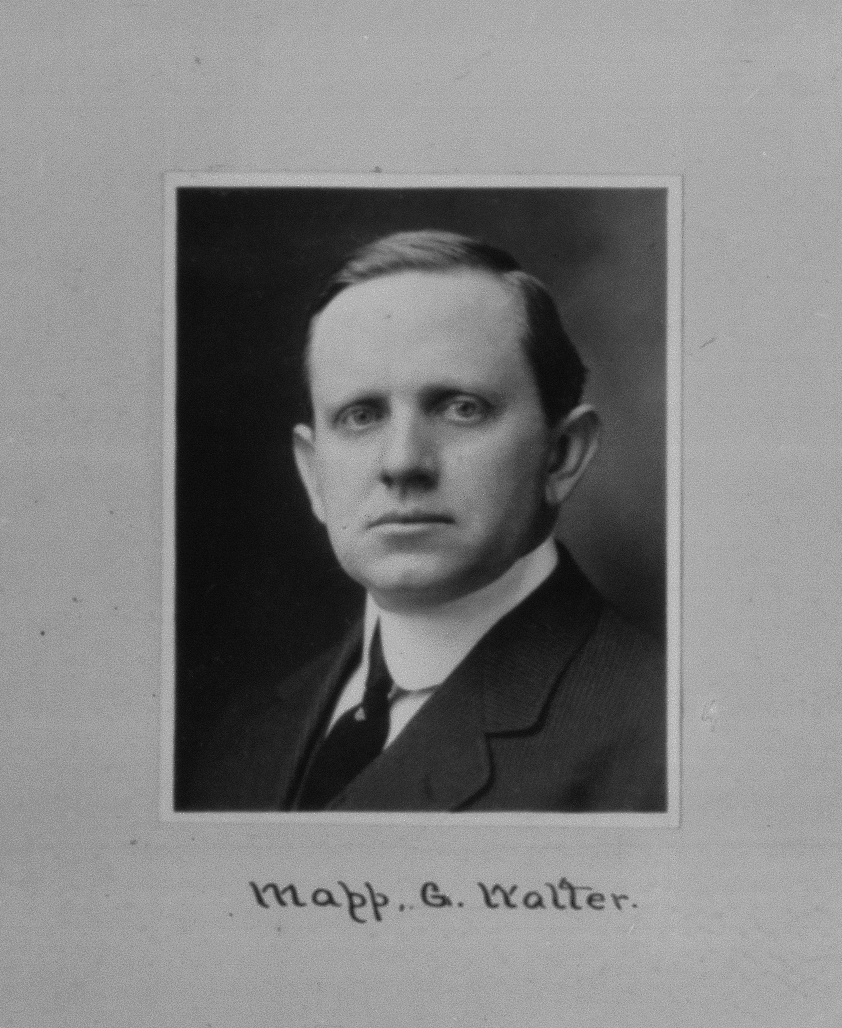
Image courtesy of the Library of Virginia.
Another Richmonder — Adèle Clark, a founding member of the state’s ESL in 1909, and chair of the Virginia League of Women Voters (1921-25; 1929-44) — corresponded with Wachapreague native and strong supporter of women’s suffrage, George Walter Mapp, who served 12 years in the state Senate after being initially elected in 1912. An accomplished artist and arts advocate who taught art in Richmond, Clark was a New Deal fieldworker and worked to educate women voters after they won the right to vote and to influence Congress and the Virginia General Assembly on issues of special interest to women.
Even in the early part of the last century, there was concern about presidential votes being challenged. Among Mapp’s papers archived at the College of William & Mary’s Swem Library is a Feb. 21, 1920, letter from Clark to Mapp, explaining she and suffragist colleagues had “copied from some of the statutes of Virginia the first laws bearing on Presidential suffrage, which seem to my lay mind to pretty definitely state that authority for the acts of the Legislature in regard to Presidential suffrage rests upon the United States Constitution. … It seems to me that if the Presidential election could be challenged because of women voting under Presidential suffrage laws enacted by State Legislatures, we are destined to have a rather widespread act of challenges. … I should think Virginia would find herself in good company. The women of Illinois did vote for President in 1916 under their State Presidential Suffrage law, and the vote was unchallenged.
“I hope you rested this afternoon, and are feeling better. With regards to Mrs. Mapp, I am very sincerely yours, Adèle Clark.”
Women’s Votes vs. Black Votes
Discussion at this time — as in other critical periods, such as the Civil War — is of the preeminence of the United States Constitution over individual states’ constitutions. As a backdrop to the dram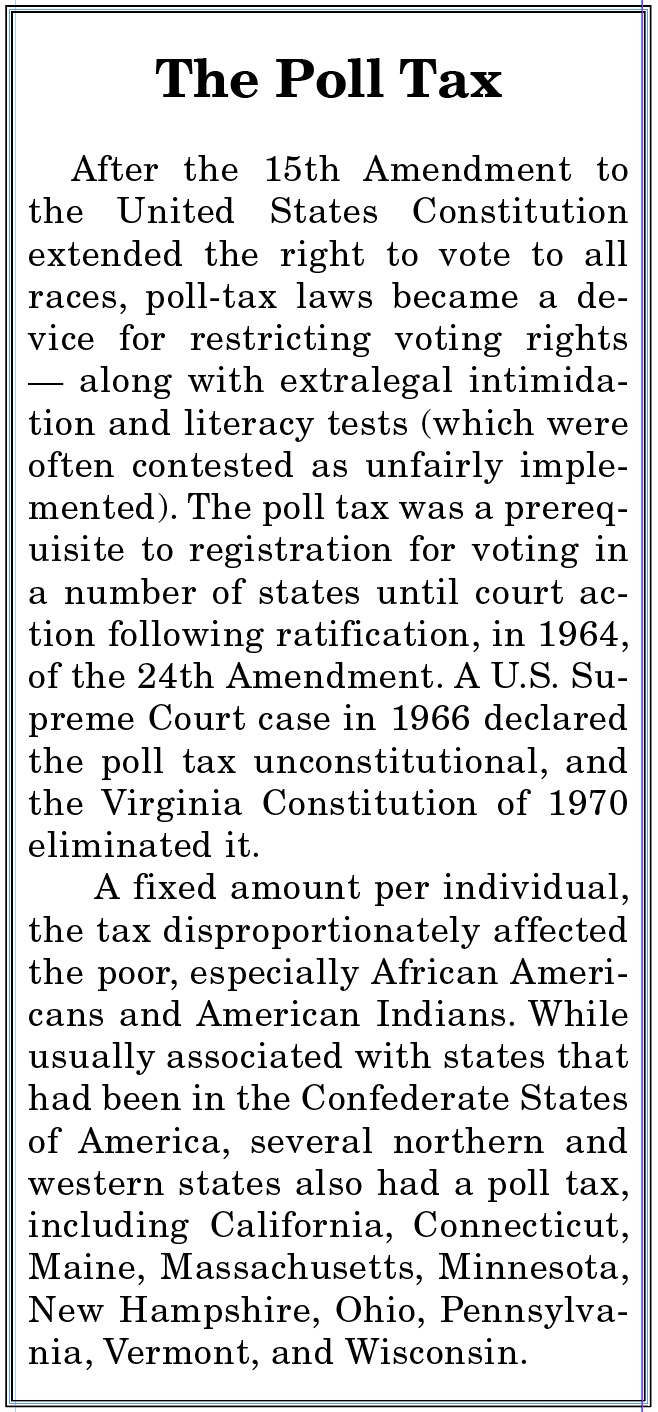 a — and sometimes, the fear — of women voting was the greater fear of increasing votes by newly emancipated African Americans. Despite the restrictions Virginia and other Southern states had put on voting by formerly enslaved people during and after Reconstruction through Jim Crow laws, women’s votes could offset, in the views of some White men, votes by Blacks. Northern Neck banker W.T. Mayo, in a telegram to Adèle Clark on Jan. 24, 1920, said, “…Virginia should not lag behind a moment endorsed by the best thought of the civilized world. I fail to see the danger of the federal amendment. The women of our day can be trusted to elevate the balance above the danger of Negro dominancy.”
a — and sometimes, the fear — of women voting was the greater fear of increasing votes by newly emancipated African Americans. Despite the restrictions Virginia and other Southern states had put on voting by formerly enslaved people during and after Reconstruction through Jim Crow laws, women’s votes could offset, in the views of some White men, votes by Blacks. Northern Neck banker W.T. Mayo, in a telegram to Adèle Clark on Jan. 24, 1920, said, “…Virginia should not lag behind a moment endorsed by the best thought of the civilized world. I fail to see the danger of the federal amendment. The women of our day can be trusted to elevate the balance above the danger of Negro dominancy.”
This was a low bar for the Women’s Suffrage Movement — especially given the mighty effort put forth by so many women – Black as well as White. Because of the racial tenor of the era, the majority of White women didn’t think outside of the box; they gave no thought to Black women, who had far greater, unacknowledged hurdles to cross.
Apologists for White suffragists will say this was simply what life was like in the early part of the last century – before a courageous White woman like Eleanor Roosevelt insisted on the recognition of Black women as the equal of White women. This “oversight” by White suffragists does not lessen the trials and suffering endured by them, many of whom were arrested and tortured in prisons like the Occoquan Prison Farm in Lorton, Va., but it reminds the beneficiaries of their work that no movement is without its moral issues.
Beyond the Banners: A Beginning
What women commemorate in 2020 is the taking of a first step — albeit an important one — for women, even if it was sometimes seen, in the candor of the Virginia banker, a counter to potential “Negro dominancy.” The amendment was a milestone for democracy; its commemoration leads to the exploration of its relevance to the issues of equal rights today.
Informed women knew the passing of the amendment did not guarantee anything; least of all, the right to vote for Black women. Its passage did pave the way for Black women such as the educator and activist Mary McLeod Bethune to move forward, knowing the work had just begun. Bethune’s work in 1920 to register and mobilize Black voters in her hometown of Daytona, Fla., resulted in new Black voters outnumbering new White voters in the city. A reign of terror followed, led by the Ku Klux Klan’s marching on Bethune’s boarding school for Black girls.
To their credit, some of the same women — such as Adèle Clark — who worked for suffrage also supported the desegregation of public schools. A lot of them were also active in temperance activities before, during, and after Prohibition because temperance was very much a women’s rights issue in an era of little legal recourse when an alcoholic husband and father could leave a family destitute. Even if a woman was successful in obtaining a divorce, her husband could easily end up being the sole guardian of their children.
If Americans are more sanguine about women’s rights in 2020, the big question in light of a Black woman’s candidacy for vice president of the United States is whether citizens can trust in a woman’s ability to lead. November’s results will go down in history as more fodder for future historians looking at suffrage.
